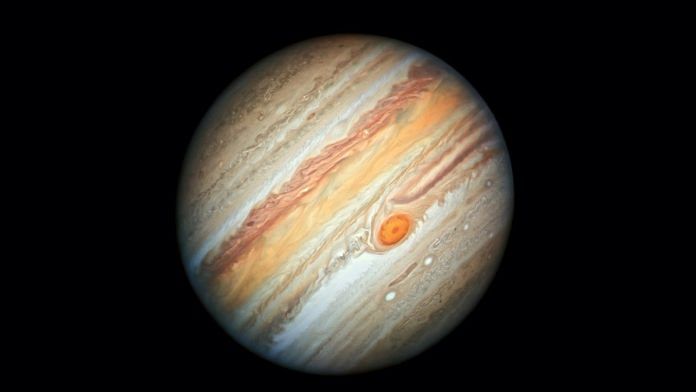New Delhi: Jupiter, the largest planet in the solar system, is also an architect of the early solar system. A study by Rice University in the US, published in Science Advances journal on 22 October, looked at how the early growth of Jupiter, around 4.6 billion years ago, changed the formation of primitive meteorites, inner planets like Earth, Mars and Venus, and even disturbed certain aspects of the Sun.
Jupiter was one of the first planets to form, right after the Sun. At this time, the solar system was just gas and dust all around, and the Sun formed by drawing all that material towards itself. With the early Sun in the middle of the solar system, all the gas and dust just formed what is known as a protoplanetary disk around the Sun. It was from this disk that all other planets and asteroids, and meteorites were supposed to have formed.
However, the Rice University research showed that when Jupiter formed, it was so big and its gravitational pull so strong that it created ripples in this disk. Jupiter’s formation created what the scientists called ‘traffic jams’ of planetary material in different parts of the solar system, which in the future led to the formation of meteorites. Most importantly, Jupiter was possibly responsible for the Earth being what it is. When planets like Earth, Mars and Venus formed, so close to the Sun, there was a huge risk that the Sun’s strong gravity would just pull them into the Sun. But it was Jupiter’s presence and its opposing gravitational force that kept the Earth in place, showed the study.
New ‘devil’ bee species in Australia
Researchers from Curtis University have discovered a new ‘devilish’ bee species in Australia, which they have aptly named Megachile (Hackeriapis) Lucifer. A new paper in the Journal of Hymenoptera Research, published on 11 November, described the discovery of a particular female bee that had two perfect little devil-like horns on its head.
This isn’t the only special thing about the bee. The bee was found on a rare wildflower that is native to the Goldfields region of Western Australia, and is a rapidly disappearing species. The researchers performed DNA barcoding on the bee and confirmed that it was a previously unknown species. The paper explained that both the bee and the rare wildflower could be at risk from habitat loss and climate change. It also called for greater effort by mining and conservation groups to survey native bees before they begin developing an area.
How do male pregnancies work? Let’s learn from seahorses
Seahorses are commonly known as one of the only animals where the males get ‘pregnant’ and carry the foetus to birth. Now, a new study has explained and studied the hormonal and other changes male seahorses go through to carry offspring. Published in Nature Ecology and Evolution on 11 November, the study was conducted by Germany’s University of Konstanz.
Female seahorses deposit their eggs into the male’s brood pouch, which is where the eggs are fertilised and carried until birth. The study found that, unlike in mammals like humans, it is the male hormones called androgens which develop this placenta-type structure inside the brood pouch of the seahorse. It is similar to the way the female uterus is prepared with a lining before pregnancy.
Another main feature the study found is that the male seahorses lack an important gene called Foxp3, which protects the body’s immune system. It is essential for the body not to attack its own tissues, like its own baby. But the seahorses still carry their babies, and their hormones sometimes help maintain the pregnancy and ensure the body doesn’t reject it.
Instead of just a reversal of roles, the way the male seahorse responds to pregnancy at the cellular level is very different from the way the female of other species do, said the study.
Easy fix for artificial light pollution
Finally, there is one kind of pollution that is slowly destroying the world but has a quick and easy fix: Artificial light pollution. A new study published in Nature Climate Change on 12 November says that Artificial Light At Night (ALAN) is disrupting the level of carbon in the world, because it is increasing the amount of carbon released by ecosystems, while not helping with carbon absorption.
The authors found that light pollution at night is increasing the release of carbon dioxide by plants, microbes, and animals, and all this carbon stays in the atmosphere. They found this by using satellite data and 86 carbon flux monitoring sites across North America and Europe, showing that the effects of artificial light pollution at night is at continental levels.
The study also said that artificial lighting covers about 25% of Earth’s land surface and grows 2% annually. But the fix is so easy. All you need, said the study, is better lighting design—such as dimmable and directional lights. This could massively reduce this overlooked environmental threat.
(Edited by Viny Mishra)
Also read: How 2 PhD students helped James Webb telescope see better with AI, from their desks on Earth






